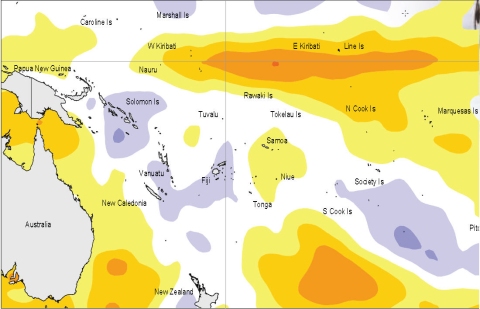El Niño/Southern Oscillation (ENSO)
Moderate-to-strong El Niño conditions continue in the equatorial Pacific, but the event is showing signs of weakening. The Southern Oscillation Index (SOI) has risen from a value of –1.7 in February to –1.4 in March, with the 3-month mean SOI steadied around –1.4. Tropical OLR anomalies weakened in March relative to the previous month, but still show strongly negative anomalies about and east of the Date Line and positive anomalies over Indonesia. The 30-day mean TRMM ENSO index stood at +0.5 in late March, and Trade winds across much of the equatorial Pacific have become reestablished during following a westerly wind burst during February. The Equatorial sea surface temperature anomalies that weakened in February have also steadied somewhat in March.
The NINO3 anomaly is around +0.7°C for March (JFM mean of +0.9°C), and the NINO4 anomaly is +1.2°C (JFM mean +1.2°C). Upper-ocean equatorial heat content is still strong in the central and eastern parts of the Equatorial Pacific and sub-surface warming (centred near 150m depth) has moved eastwards and risen to a depth of less than 100m. Moderate MJO activity in the Indian Ocean in late March is expected to weaken in early April.
Around half the dynamical models (but no statistical models) NIWA monitor show El Niño conditions through to the end of May 2010. All models show neutral conditions for the austral winter.

Sea surface temperature anomalies (ºC) for April 2010
